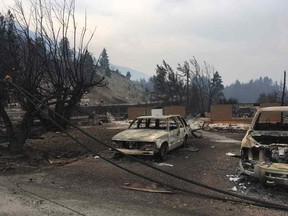The study found that the heat dome was 34 percent larger and lasted 59 percent longer than it would have without the effects of global warming.

Article content
The deadly heat dome that covered British Columbia for nearly a month in 2021 was significantly worse due to human-caused climate change, according to a new study.
The study, Published this week in Communications Earth and Environment, it found that the heat dome was 34 percent larger and lasted 59 percent longer, or 27 days longer, than a heat wave would have without the effects of global warming. caused by humans.
Advertisement 2
Article content
Article content
By analyzing 40 years of data on heat waves and wildfires, Canadian and American researchers found that the largest number of high temperature and low humidity records were broken in 2021, most of them in July of that year.
The deadly heat wave stretched from June 18 to July 14, sending temperatures soaring into the 40s in British Columbia, Washington and Oregon. Lytton hit a record high of 49.6C on June 29, the day before a bushfire destroyed the village. The BC Coroners Service confirmed 619 heat-related deaths during that time. Hospitals became dangerously hot and equipment failed.
While there is already a well-established link between heat waves and wildfires, this study shows how the heat dome was more intense due to human-caused climate change, said Piyush Jain, lead author of the study and research scientist at Natural Resources Canada.
“If the heatwave hadn’t been as intense or shorter, we probably wouldn’t have seen many of those records like Lytton reaching 49.6C,” he said in an interview on Thursday.
Jain, who also co-wrote a separate study about last year’s record wildfire season in Canada, he said the same goes for the extreme wildfires that occurred during and after the heat dome.
Article content
Advertisement 3
Article content
According to the study, across the Pacific Northwest, wildfires burned 32,000 square kilometers of forest in 2021. Of this, 21 percent of that burned land was due to wildfires that ignited during the heat dome. That figure rises to 34 percent within 10 days of an extreme heat wave.
“Of course, those extreme temperatures allow vegetation to dry out. And the more extreme, the drier those fuels are and the more susceptible they are to burning,” he said. “So in the future, if we see more warming due to climate change, we may see more of these extreme events… and they may be larger and more intense.”
Jain said scientists are concerned that the longer these heat waves last, the larger the feedback loop will be with water and land surface temperatures, all of which can further amplify events related to the climate crisis. like forest fires.
For example, heat from wildfires can generate cumulonimbus clouds that can cause dry lighting. This happened with the 2021 Lytton and Sparks Lake fires, which generated more than 50,000 cloud-to-ground lightning strikes over an eight-hour period, sparking even more fires, according to the study.
Advertisement 4
Article content
“Very often that lightning can be dry lightning. Therefore, it has no associated rain. And that’s a big concern for wildfires,” Jain said. “The fire generated the cloud that caused new fires. That is an example of unintended or unexpected feedback.”

The researchers conclude that climate change will continue to magnify heat dome events, increasing fire danger and causing more extreme wildfires in forested areas of North America.
The study also notes that during the heat dome, North America set a record number of days at national preparedness level five, the highest level. However, that record was broken last year in Canada, Jain said, when the country was at level five for 120 consecutive days due to wildfires across the country.
In the 2023 wildfire study that Jain co-wrote, researchers said the May to October temperature in Canada was a staggering 2.2 C warmer than normal, contributing to extreme weather conditions sustained throughout the wildfire season. fires.
Recommended by Editorial
-

British Columbia hospitals became dangerously hot and equipment failed during heat dome: report
-

BC implements improvements since 2021 heat dome, but are they enough?
-

British Columbia and Yukon are among the world’s top regions for climate change-induced heat this summer: study
-

BC Wildfire Map 2024: updates on fire locations, alerts/evacuation orders
Bookmark our website and support our journalism: Don’t miss the news you need to know – add VancouverSun.com and LaProvincia.com to your favorites and subscribe to our newsletters here.
You can also support our journalism by becoming a digital subscriber: for just $14 a month, you can get unlimited access to The Vancouver Sun, The Province, National Post and 13 other Canadian news sites. Support us by subscribing today: The Vancouver Sun | The province.
Article content




